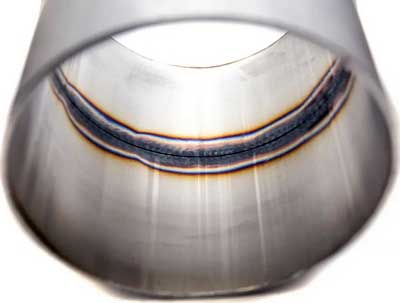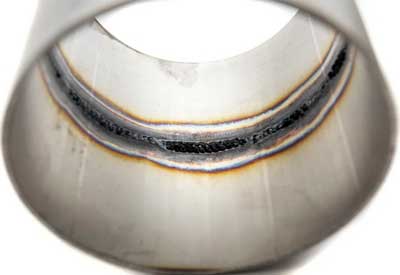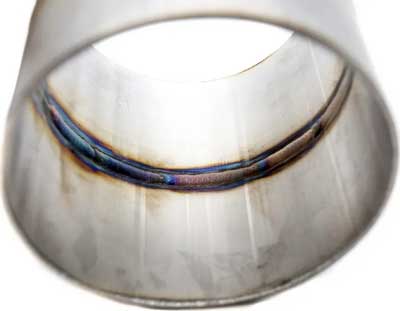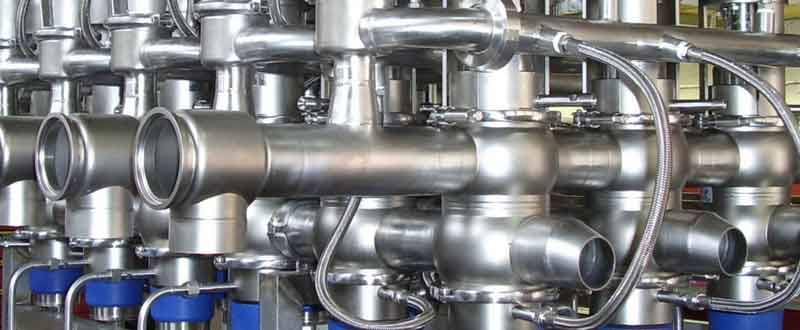Weld protection of stainless steel pipes - Explanation of purging methods |
Back purging is the process of shielding the inside of the weld with an inert gas to prevent contamination during the welding process, resulting in a stronger weld, discoloration of the weld and loss of corrosion resistance.
Wikipedia extrapolates on this statement: Stainless steels, duplex steels, titanium-, nickel- and zirconium- alloys are sensitive to the presence of air, oxygen, hydrogen, water vapour and other vapours and gases that may combine with the hot metal as it is being joined.
Purging stainless steel tubes
Purging with inert gas to prevent discoloration of the weld substrate and loss of corrosion resistance is relatively common in stainless steel fabrication. However, very little quantitative published information is available to the welder regarding purge gas quality and types of purging techniques.
High-quality joints in stainless steel between cylindrical sections such as pipes and tubes can only be made by ensuring that atmospheric gases are eliminated during the welding process.
The presence of gases, especially oxygen, around the molten weld can lead to a variety of defects. Discoloration is unsightly and in some cases can cause metallurgical imbalance.
Coarse oxidation inevitably leads to a reduction in mechanical properties and can cause catastrophic loss of corrosion resistance. Nitrogen contamination can lead to brittleness. Gases in the weld may give rise to cracking during or after cooling.
The quality of the weld root when making pipe joints can be guaranteed by taking proper precautions based on removing air from the melting zone and supplying inert gas. This is achieved by gas purging.
Common purge gases
The most commonly used purge gases for welding stainless steel in the U.S. are commercial grade Argon and Helium. Purge gas flow rates and pressures must be established and once selected should be incorporated into the formal welding procedure.
Variations in the quality of the purge gas may occur during the welding process and it may be desirable to apply continuous gas monitoring, especially to control oxygen and moisture content. Special oxygen welding monitors are commercially available for this purpose.
The first requirement is to provide gas inlet and outlet points. The gas is fed through an end seal with an outlet at the other end to prevent unwanted pressure buildup.
Argon shielding gas has a higher density than air and the gas inlet should be at a lower height than the vent end so that air is effectively expelled from the pipe bore. The reverse is true for Helium, which is lighter than air.
For small pipes and tubes, with small internal volume, the cost of continuous blow-through is not always significant. Under these circumstances, wooden or plastic discs simply glued to the pipe ends are sufficient.
If complete purging is impractical, such as because the pipe volume is large or access is difficult, alternative containment techniques are available.
Some photo examples of pipe welds
Weld 1: Lack Of Penetration (No Back Purging)

This butt weld lacks full burn-in, exposing the root gap. During the welding process, this gap can provide a better, stronger weld. If left unfilled, it can attract moisture and corrode faster than the rest of the system. Without full penetration into this butt weld, this is a weak weld with reduced strength - it is a point of failure.
Weld 2: Sugaring (No Back Purging)

Sugaring / granulation / fouling is extreme oxidation of the back of a stainless steel weld. This weld has burn-in but is also highly oxidized due to the lack of a shielding gas. Although this weld has complete burn-in, it is not as strong as a back purged weld and is also a point of potential rusting and/or fracture under stress. To a slight degree, sugaring also interrupts the flow of exhaust gas. Sugaring is often a reject defect in the medical/food industry because the texture can trap bacteria.
Weld 3: Back Purged Weld

Ultimately, strength, longevity and minimal impact on flow are the end goals of a purged weld. This weld is made with the same settings as the weld above, but blown through with Argon. The inert gas prevents burning and fouling for a visibly different weld. There is full penetration with no contamination on the back side. Not only is it beautiful and well done, but it is also quite strong.
Questions? Comments? Let me know!
Related Post(s)

The name orbital welding comes of the circular motion of welding tool around the workpiece. In general, orbital welding technology includes coverage two main application areas...